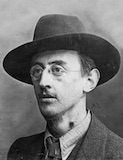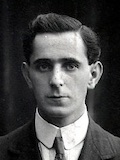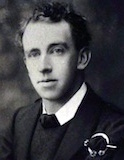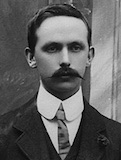
Short biographies of the seven rebels who signed Ireland’s historic declaration of independence in 1916. The second in a two-part series.

JOSEPH MARY PLUNKETT (1887-1916)
Born in Dublin, he was the son of a papal count, George Noble Plunkett. Plunkett was educated by Jesuits at the Catholic University School, Belvedere College and Stonyhurst College in Lancashire, England.
A gifted writer, he met Thomas MacDonagh when he was tutored by him in Irish in preparation for the University College, Dublin matriculation examinations.
MacDonagh was to become a close friend, as both were interested in poetry, religion and mysticism.
Plunkett graduated from UCD in 1909 but he contracted tuberculosis as a young man and spent periods in Italy, Algeria and Egypt in the years 1910-12.
Plunkett edited the Irish Review, supported Arthur Grith’s Sinn Fein and took the workers’ stand during the 1913 lock-out.
Along with MacDonagh and Edward Martyn, Plunkett also helped to establish an Irish national theatre.
He was elected to the provisional committee of the Irish Volunteers in 1913 and later became a member of the IRB and fully committed to armed revolution. In April 1915 Plunkett went to Germany to assist Roger Casement in procuring arms and assistance for the Easter rebellion.
Plunkett and Mac Diarmada are believed to have forged or at least “sexed-up” a document released on April 19, 1916, supposedly emanating from Dublin Castle, which suggested the authorities were about to crack down on Irish Volunteers and the rising nationalism.
With James Connolly and Sean Mac Diarmada, Plunkett was involved in the military strategy for the insurrection and was the youngest signatory of the Proclamation.
In poor health and recovering from an operation on his glands, Plunkett still joined other members of the Provisional Government in the GPO for the Rising.
He married Grace Giord -- a sister-in-law of Thomas MacDonagh -- at Kilmainham the night before he was executed.
Just before he faced the firing squad, on May 4, 1916, he said: “I am very happy I am dying for the glory of God and the honour of Ireland.”
The main railway station in Waterford city is named after him, as was the Joseph Plunkett Tower in Ballymun, and Plunkett barracks in the Curragh Camp, Co Kildare.

SEAN MAC DIARMADA (1883-1916)
Born in Leitrim, he emigrated to Glasgow in 1900 where he worked as a tram conductor, and from there came back to Belfast in 1902. A member of the Gaelic League, Mac Diarmada was sworn into the IRB by Denis McCullough, and transferred to Dublin in 1908 where he managed the IRB newspaper Irish Freedom in 1910.
Although afflicted with polio in 1911 and needing a walking stick, together with Tom Clarke, McCullough and Bulmer Hobson, Mac Diarmada is credited with revitalising the IRB and becoming a popular leader.
After the outbreak of the First World War in August 1914, he campaigned against Irishmen joining the British army, and was jailed under the Defence of the Realm Act.
In a speech at Tralee, Co Kerry he claimed: “The Irish patriotic spirit will die forever unless a blood sacrifice is made in the next few years.”
Mac Diarmada was said to be obsessively secretive in his planning, excluding many of his fellow IRB men from the Rising conspiracy.
A signatory of the Proclamation and a member of the Provisional Government, he spent the Rising in the GPO.
Before his execution, Mac Diarmada wrote: “I feel happiness the like of which I have never experienced. I die that the Irish nation might live!”
He was executed by firing squad at Kilmainham on May 12. Mac Diarmada was unmarried.
Sean McDermott Street in Dublin is named in his honour as is Mac Diarmada rail station in Sligo, and Pairc Sean Mac Diarmada, the GAA ground in Carrick-on-Shannon. Sean MacDermott tower in Ballymun, which was demolished in 2005, was also named after him.

THOMAS MACDONAGH (1878-1916)
A native of Tipperary, MacDonagh trained as a priest but like his parents became a teacher, and was on the staff at St Enda’s, the school he helped to found with Padraig Pearse.
A gifted poet, writer and dramatist, in 1909 MacDonagh was a founding member of the Association of Secondary Teachers of Ireland (ASTI), and also was active in setting up the Irish Women’s Franchise League in 1911 which promoted Irish nationalism and the cultural revival. His play When the Dawn is Come was produced at the Abbey Theatre.
MacDonagh joined the Irish Volunteers in November 1913, becoming a member of the provisional committee and taking part in the Howth gun-running.
He believed Irish freedom would be achieved by what he called “zealous martyrs”, hopefully through peace but, if necessary, by war.
Although a member of the IRB from April 1915, MacDonagh was not co-opted to the Military Council until early April 1916, and so had little part in planning the Rising. He is believed, however, to have contributed to the content of the Proclamation.
As one of the four Dublin battalion commandants, MacDonagh was in charge at Jacob’s biscuit factory in Bishop Street. His two most senior officers were Major John MacBride and Michael O’Hanrahan.
Survived by his wife Muriel Giord and his children Donagh and Barbara, MacDonagh was executed by firing squad at Kilmainham Jail on May 3, 1916.
Thomas MacDonagh Tower in Ballymun, Dublin, was named after him, as was the train station in Kilkenny. He briefly worked as a teacher at St Kieran’s College, Kilkenny.

EAMONN CEANNT (1881-1916)
Son of a RIC officer, Ceannt was born in the police barracks at Ballymoe, Co Galway. He was in command of the 4th Battalion of Irish Volunteers at the South Dublin Union in 1916, which is now the site of St James’s Hospital.
Ceannt was a founder member of the Irish Volunteers and a signatory of the Proclamation of Independence.
He attended the O’Connell Schools on North Richmond Street run by the Christian Brothers, and University College Dublin. Ceannt joined the Gaelic League in 1900 where he met Patrick Pearse and Eoin MacNeill, adopted the Irish form of his name, and founded the Dublin Pipers’ Club.
A fluent Irish speaker, he worked as an accountant with a reported salary of #300 a year in the City Treasurer’s Office, Dublin Corporation. Ceannt joined Sinn Fein in 1907 and was sworn into the Irish Republican Brotherhood in 1912.
On the foundation of the Irish Volunteers in November 1913, he was elected to the provisional committee, becoming involved in fundraising for arms.
Married to Aine O’Brennan, they had a son Ronan. Ceannt’s brother William, was a sergeant-major in the Royal Dublin Fusiliers (British army) stationed in Fermoy, Co Cork.
Aine Ceannt later founded the White Cross to help families impoverished by war.
It is said that during the fighting in the South Dublin Union Eamonn Ceannt remained calm and brave at a position his men held until learning of the surrender on Sunday.
He faced the firing-squad at Kilmainham Gaol on May 8, 1916.
Galway City’s Ceannt Station in his native Galway, as well as Eamonn Ceannt Park in Dublin and Eamonn Ceannt Tower in Ballymun were named after him.
![[Irish Republican News]](https://republican-news.org/graphics/title_gifs/rn.gif)
![[Irish Republican News]](https://republican-news.org/graphics/title_gifs/harp.gif)

